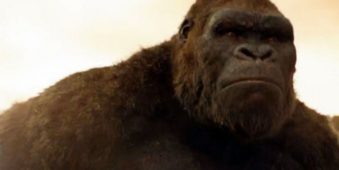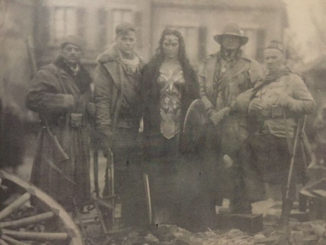 Note: Some minor spoilers for the end of the film will be mentioned.
Note: Some minor spoilers for the end of the film will be mentioned.
If you came out of 2014’s Godzilla wishing that there had been more giant monster fighting action, there’s some good news for you. Kong: Skull Island, also set in Warner Brothers’ burgeoning MonsterVerse franchise of interconnected films, packs more of what you may have missed that first time around. But all the excitement does not come at the expense of the all the people running around underfoot.
It is 1973. The Vietnam War is winding down when a mapping satellite discovers a previously uncharted in the south Pacific. Bill Randa (John Goodman) feels that the island could hold the proof that the mission of Monarch, the underfunded government agency tasked with finding giant monsters he is in charge of, is not as crazy as it may seem. Randa and his assistants are allowed to join an expedition heading to the island consisting of geologists, an expert tracker (Tom Hiddleston), a war photographer (Brie Larson) and a group of airborne rangers led by Samuel L. Jackson. Almost as soon as they arrive on the island, Randa’s theories about giant monsters are validated when the group is attacked by a 100-foot tall ape. And he might not even be the most deadliest monster on the monster on the island.
Set some four decades before 2014’s Godzilla, Kong: Skull Island still manages to create some strong ties to the former film to help establish the MonsterVerse franchise. We see the early days of government agency Monarch, the group tasked with hunting down giant monsters, and learn that it was Randa’s encounter with Godzilla during World War Two that led him to found the group. The film also apes (sorry) the montage of documentary-style footage that Godzilla used to establish some of the hidden history of the century concerning giant monsters and the government’s attempt to destroy them without the public finding out. It is a fun conceit that hints at a larger canvas than the individual films can adequately explore on their own. Hopefully it will become a staple of the MonsterVerse films as we work our way over the next couple of years through 2019’s Godzilla 2 and 2020’s Godzilla Vs Kong.
 Director Jordan Vogt-Roberts really feels like he’s having fun here. The film is not so overindulgent in the way that perhaps Peter Jackson’s 2005 King Kong was at times. Instead, there is the impression that Vogt-Roberts is enjoying flexing his creative muscles whether he is putting us into the middle of a number of helicopter crashes or visually referencing Coppola’s Apocalypse Now. The film may be have a different tonal feel than it’s franchise predecessor Godzilla, but that’s fine. The two are set in different time periods, so the differing styles works for each film. It is nice to see that Warners didn’t force a certain homogeneous visual style on this franchise the way they have with their DC Extended Universe superhero films or Disney has with their Marvel Cinematic Universe.
Director Jordan Vogt-Roberts really feels like he’s having fun here. The film is not so overindulgent in the way that perhaps Peter Jackson’s 2005 King Kong was at times. Instead, there is the impression that Vogt-Roberts is enjoying flexing his creative muscles whether he is putting us into the middle of a number of helicopter crashes or visually referencing Coppola’s Apocalypse Now. The film may be have a different tonal feel than it’s franchise predecessor Godzilla, but that’s fine. The two are set in different time periods, so the differing styles works for each film. It is nice to see that Warners didn’t force a certain homogeneous visual style on this franchise the way they have with their DC Extended Universe superhero films or Disney has with their Marvel Cinematic Universe.
If there’s one thing that feels like a studio note, it is the amount of needle drops of early 1970s music that the films uses, especially in the films opening half hour. I can only imagine that some Warner Brothers exec saw all the music in the opening of last year’s Suicide Squad and sent a copy of the Good Morning Vietnam soundtrack over to Vogt-Roberts and company as they labored away on post-production.
The movie does a good job at fleshing out most of its cast with at least a small bit of characterization so we will hopefully be rooting for all of them to make it off the island alive. Alas, as what often happens when a large group of people trek across a monster-inhabited island, not everyone is going to make it. Some of the deaths you can see coming, but some are quick, unexpected and keep the suspense level going for the film.
Probably the strongest character of the piece is Jackson’s Lt. Colonel Packard. Packard’s quest to save his stranded comrade starts off as Saving Private Ryan but quickly spirals out of control to Moby Dick territory as he sees more and more of his men killed by Kong and the other creatures in the island. Part of this descent is fueled by his own disillusionment over the outcome of the Vietnam War. In a genre where military men are often very two-dimensional, Packard has a bit more tragic depth to him that makes it hard to hate him for wanting to kill the film’s titular star.
Unfortunately, the film’s two biggest duds are Hiddleston and Larson’s couple, the nominal leads. There’s not much chemistry between the two, either generated by the script or the performers themselves. Screenwriters Dan Gilroy, Max Borenstein and Derek Connolly smartly keep Larson’s Mason from being the damsel-in-distress/object-of-Kong’s-affection, but don’t give her much to do in return.
But for all its pluses, one comes away from the film not really feeling an empathy for Kong. Key to both the 1933 original and Jackson’s remake was that they made you care about Kong and were moved at his ultimate fate so far away from his home. Here, the film is only two-thirds a remake with Kong never leaving the island. And while the audience’s understanding of Kong and his role on the island evolves over the course of the film, Kong never quite goes on an kind of a journey as a character.




